Marshall Islands 2015 "Dinosaur Bones"
| <prev | back to index | next> |
| Issue Date | 15.01.2015 |
| ID | Michel: 3450-3453; Scott: 1102a-d; Stanley Gibbons: 3315-3318; Yvert et Tellier: 3359-22362; Category: pR |
| Design | D. Zoe Seemel, Artwork: Bryan Kneale |
| Stamps in set | 4 |
| Value |
c34 - Triceratops c34 - Stegosaurus c34 - Protoceratops c34 - Tyrannosaurus |
| Emission/Type | commemorative |
| Places of issue | Majuro |
| Size (width x height) |
stamps: 10 mm x 31 mm Sheet: 184 mm x 152 mm |
| Layout | Sheet of 16 stamps (4 strips of 4 stamps) |
| Products | none |
| Paper | unwatermarked gummed paper |
| Perforation | 13.50 x 13.50 |
| Print Technique | Black, cyan, magenta, yellow by offset lithography |
| Printed by | Pioneer Printing, Cheyenne, Wyoming, U.S.A. |
| Quantity | |
| Issuing Authority | Marshall Islands Postal Service. |
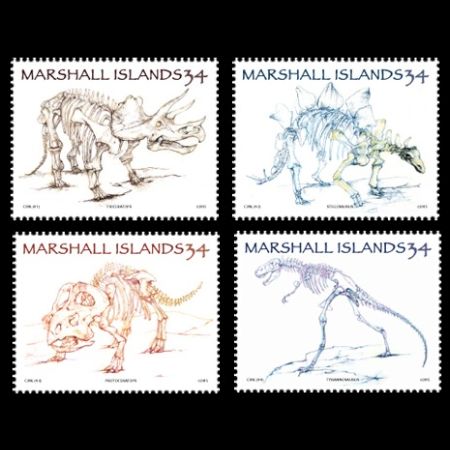
In March 2015, the Marshall Islands Postal Service introduced at their on-line store the set of four stamps showing "Dinosaur Bones", while the official issue day was announced as January 15th, 2015. The stamps were printed in a sheet of five strips.
These stamps designs were based on the artworks created by Bryan Kneale, who painted the set of six images "Dinosaur Bones" in 1990. Kneale's paintings were originally published on the cachets of Fleetwood's First Day Cover for the "150th Anniversary of Dinosaurs' Identification by Sir Richard Owens" stamps of the Royal Mail in 1991.
Bryan Kneale was born in 1930 on the Isle of Man and attended Douglas School of Art (1946-47)
and the Royal Academy Schools, London (1948-1949).
Kneale was initially a figurative painter, but started making sculpture after attending a
welding course in 1960.
Since the mid-1980s Kneale's major source of inspiration has been the skeletons
and joints of animals he studied and drew at the Natural History Museum in London.
In an interview to "Tate" website, Kneale related his fascination to a sculptural
interest in structure and form:
I have always found in all my work it
is the connections, the articulation of form which has been of
particular importance to me, rather than the development of sculptural mass.
The endless invention in nature of bony structures from minute tiny insects
and animals to colossal forms of dinosaur bones … has always fascinated me.
Between 1989 and 2018 the Marshall Islands outsource the production of their stamps to the USA-based company, Unicover Corporation (discontinued in 2018).
Unicover Corporation was privately owned, they have had a wide-reaching artwork
originals business.
Their principal subsidiary, Unicover World Trade Corporation, was markets postage
stamps in North America for various postal administrations from around the globe.
One of the subsidiary companies of Unicover was Fleetwood (acquired by Mystic in 2007).
Fleetwood was FDC maker company, since 1929, who create unique cachets for their covers,
based on the artwork collection of Unicover Corporation.

Dinosaur bones on FDC of Fleetwood with stamps of Great Britain 1991
The following text was written on the reverse side of FDCs produced by the Fleetwood company in 1991, with some notes added by the author of this website.
More than one hundred and forty-five million years ago, giants roamed the tropical expanses of a young earth caught in the perpetual summer of the Mesozoic Era. From small, chicken-sized creatures to behemoths weighing more than seventy tons, dinosaurs existed as stalking carnivores or browsing herbivores, and their titanic clashes as predator and prey thundered across the primordial plains. Extinct for eons, dinosaurs continue to captivate imaginations and stimulate vital scientific research.
Triceratops lived and died during the Late Cretaceous Period - more than 136 million years ago.
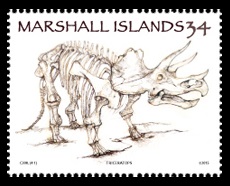 |
| Triceratops on stamps of Marshall Islands 2015, MiNr.: 3450, Scott: 1102a. |
The late Jurassic Period produced one of the dinosaur era's most unusual creatures- the Stegosaurus.
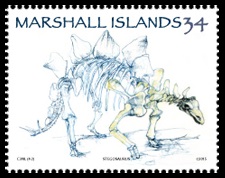 |
| Stegosaurus on stamps of Marshall Islands 2015, MiNr.: 3451, Scott: 1102b. |
Protoceratops was one of the most primitive species of dinosaur.
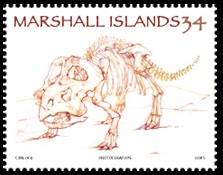 |
| Protoceratops on stamps of Marshall Islands 2015, MiNr.: 3452, Scott: 1102c. |
In 1842 British anatomist Sir Richard Owen coined the word dinosaur from two Greek words meaning "terrible lizard." Although dinosaurs were not lizards, the term aptly applied to the best known and most fearsome of all dinosaurs - the Tyrannosaurus.
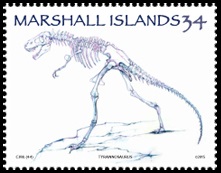 |
| Tyrannosaurus on stamps of Marshall Islands 2015, MiNr.: 3453, Scott: 1102d. |
Products and associated philatelic items
| Stamps-Sheet | ||
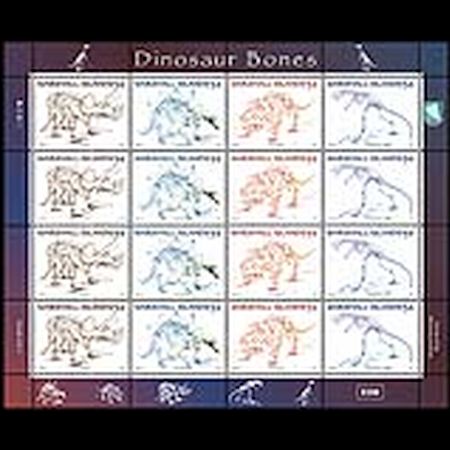 |
|
|
References
 |
- Technical details and short press releases:
Marshall Islands Stamp Catalog (this website does not exist anymore), Unicover (this article does not exist anymore),
colnect. - Bryan Kneale:
Wikipedia, Interview to "Tate" website (this article does not exist anymore). - Descriptions of the dinosaurs:
Web Archive
Acknowledgements
Many thanks to Dr. Peter Voice, PhD Department of Geological and Environmental Sciences, Western Michigan University, USA, for reviewing of a draft of this article.| <prev | back to index | next> |